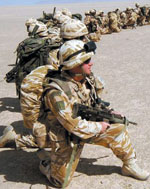 |
| British troops operating in Afghanistan and Iraq have an immediate need for tactical reconnaissance data. A contract between the United Kingdom’s Ministry of Defence (MOD) and the Thales Group allows the government to lease the company’s Hermes 450 unmanned aerial vehicles (UAVs) to provide persistent surveillance and reconnaissance. |
Unique arrangement allows the
United Kingdom to operate robot recon aircraft without the maintenance costs.
British troops operating in Afghanistan and Iraq are using privately owned and maintained unmanned aircraft for battlefield reconnaissance and surveillance missions. The effort effectively leases the aircraft to the military while the private firm covers maintenance and operational costs.
Demand for battlefield reconnaissance has risen constantly since coalition forces began operating in Southwest Asia. Although the number of robot aircraft has grown to meet the demand, not all nations enjoy ready access to surveillance data.
The leasing contract has been in place for just over a year, explains Alan Gordon, head of intelligence, surveillance, target acquisition and reconnaissance (ISTAR) business development for Thales Aerospace Division, Crawley, England. The contract is a service provision between Thales and the United Kingdom’s Ministry of Defence (MOD) to lease Hermes 450 unmanned aerial vehicles (UAVs) for on-demand ISTAR capabilities. He notes that the aircraft is the same platform used in the Watchkeeper program (SIGNAL Magazine, November 2005), which is scheduled to enter service in 2010. However, until Watchkeeper deploys, British forces will lack a long-endurance tactical surveillance capability in two operational theaters. The service provision meets an urgent operational requirement for long-endurance UAVs, providing what Gordon calls “ISTAR by the hour.”
The service provision provides 14-hour-a-day, seven-days-a-week service in Afghanistan and Iraq. If the MOD requires more capability, the contractor can provide a surge capacity, scaling up to 24-hour service for periods to cover high-intensity operations. Thales put the service in place in less than six months from the issuance of the urgent-needs requirement. The UAVs are now operating extensively in both theaters.
Over the last nine months, the aircraft have logged some 8,000 flying hours while conducting a range of missions, says Emmanuel Bloch, Thales Land and Joint Systems’ external communications manager, Colombes, France. The aircraft can be tasked for a variety of missions such as intelligence, surveillance, target acquisition, target recognition and battle damage assessment. He explains that the service provides a full ISTAR capability at a savings to the MOD. “All the logistics around the system is provided by Thales. The objective is to have 100-percent availability with joint support and maintenance by Thales,” he says.
Military personnel plan and control each UAV mission, but the company provides and maintains the aircraft. Gordon explains that as soon as the UAV is airborne, the military has full control of the aircraft, handing the aircraft back to the company when it returns to base. Once the UAV is on the ground, Thales personnel ready it for the next mission.
The Hermes 450’s long endurance allows it to fly up to 16 hours per mission. Gordon explains that a pair of aircraft can be assigned to take turns monitoring an area to provide round-the-clock surveillance. “The idea is that they loiter over the target. You can do multiple missions with a single UAV,” he says.
British forces operating in Southwest Asia do not have many medium or large ISTAR UAVs and primarily rely on small tactical platforms. These UAVs are small, hand-launched aircraft designed to provide an immediate battlefield surveillance capability for a company-sized or smaller unit. As opposed to the small, over-the-hill-type UAVs, the Hermes-based aircraft provide persistent surveillance. “If you’re going to do an operation, you’re going to put one of these [UAVs] up to give you cover,” he says.
Gordon says that tactical UAVs also operate on a simpler, single-mission basis with a launch, mission and recover routine. A more sophisticated UAV system such as the Hermes allows operators to multitask in the air or to take part in continual, persistent surveillance. He notes that some operations require a location to be observed for many days. “We’ve got the ability to do that,” he says.
The Hermes 450 UAV is a variant of the model that will be used in the Watchkeeper system. The contract’s Hermes 450s carry a single payload consisting of an electro-optic/ infrared/laser designator pod. For Watchkeeper, the UAV will carry a dual payload: an electro-optic package and a synthetic aperture radar. Gordon notes the Watchkeeper is a more robust platform designed to be certified to meet the United Kingdom’s and European military operational standards. Watchkeeper also will have a more robust and complex operational infrastructure integrated into the United Kingdom’s command, control, communications, computers and intelligence system. “Watchkeeper is more globally deployable to serve British sources. We’re currently in one or two theaters, but we have to be able to deploy worldwide,” he says.
 |
| The leasing contract between the U.K. MOD and Thales allows the military to operate the UAVs at a set cost while the company covers maintenance and training expenses. The leased Hermes 450 UAVs are slightly less robust versions of the Watchkeeper UAV scheduled to enter service in 2010. |
British units using the leased UAVs in the field have provided positive feedback. Gordon explains that the service provides warfighters with an active ISTAR asset in theater. “It gives them so much more than they’ve had before. They’re very thrilled with it,” he shares.
Based on the U.K. military’s experiences with the service in Southwest Asia, Gordon says that Thales is planning to provide the service to other customers. He notes that other nations operating in the same theaters have shown interest in a similar capability. One of the system’s key advantages is that it is a service provision. “That means we can reduce the time it takes to get such a capability into theater. This is because we can help with the maintenance, and we can get people in quickly. The training burden is less, and we have people on operations in both theaters. So the customer is not buying equipment, the customer is buying a service, an ISTAR provision,” he maintains.
Although Gordon does not have exact numbers, he explains that the company has enough Hermes aircraft to provide 14-hour-a-day services, seven days a week, across two theaters. “It’s the availability that we give them, it’s not a number of air vehicles,” he says.
Gordon notes that in the past, customers have purchased UAV systems with many aircraft, only to have none left after six months due to accidents and attrition from operating in a high-tempo environment. “What’s the point of that?” he asks.
Regions such as Afghanistan are hard on mechanical equipment. Gordon explains that this is why a robust system such as the Hermes 450 was selected. He adds that the aircraft and the way the program operates take the day-to-day operational risks away from the customer.
Web Resource
Thales Group, United Kingdom: www.thalesgroup.com/uk






Comments